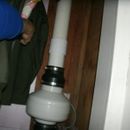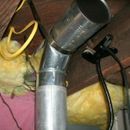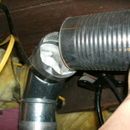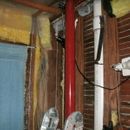Need condensation control — Want a bath vent without another 4″ hole outside
Any brainstorming helps.
Have “sealed” window in bath anyway but do not want to open in winter north Iowa.
Radon vent (other side house) condensates.
So I don’t want to make another 4″ hole for bath vent.
When I turn on radon fan I hear water slosh down in pipe that’s horizontal.
And dryer is another 3″ hole. That condensates too. (I tried manual fix. See pics.)
And vent stack is another 4″ hole.
And gas water heater is another 3″ hole out chimney.
And water pipe is another.
And windows are more holes. I installed new very carefully with jams foamed. They are so drafty that even non operational picture window billows the clear window seal film (very carefully taped too with double sided carpet tape.)
How many more holes do I make? Is this Swiss cheese house?
Afraid to make bath fan hole.
Bath interior walls open too. Yes, exterior condensated over winter.
Walls dripped sopping wet through insulation with spring thaw after all winter frozen to the sheathing.
Put in PVC vent–took out cast iron vent which condensated outside the pipe onto walls as the metal was as cold as attic.
Along side PVC stack vent, I can go up to attic again with 3″-4″ from bath fan.
I’d rather not have to deal with condensation down this pipe now.
So I’d just like to vent to inside and recirculate when bath door is closed.
So she doesn’t have to take a fan inside the bathroom and maybe shock herself (have GFCI.)
Just two of us so moisture isn’t so great.
Skin likes moisture in winter anyway.
Is there some electro-damper to 100% seal off cold air from bath vent?
Would love to just vent into exposed stack with sealed damper–code violation.
Maybe tee like dryer and stuff insulation but walls would be closed up and no access like I can get at dryer tee.
I don’t want Iowa winter 40mph wind blowing down vent into bathroom when not showering.
Appreciate brainstorming.
GBA Detail Library
A collection of one thousand construction details organized by climate and house part













Replies
C. Darwin,
If your bathroom window is a fixed (non-operable) window, then building codes (and common sense) require the installation of a bathroom exhaust fan. For more information on this topic, see Bathroom Exhaust Fans.
From your description of your house, it sounds as if (a) your house has significant air leaks and would benefit from air-sealing work, and (b) your interior air is too humid, or your house has a moisture source that needs to be identified and remedied.
To track down your home's air leaks, you can use detective work and ingenuity (along with research on the topic here on the GBA web site). However, many homeowners instead turn to a professional home performance contractor equipped with a blower door; this type of work is called "blower-door-directed air sealing."
I'm not sure why your interior air is so humid, but two possibilities are: (a) your house has a humidifier -- always a bad idea, or (b) your house has a damp basement or a damp crawl space. The first step would be to install several hygrometers around your house so that you can measure the relative humidity of your indoor air. That information can help guide a solution.
Thanks for you Martin.
Bath window is triple pane double hung krypton, but I have it sealed with the clear draft film (see pic.)
1914 house has all walls uninsulated, as yet. Will fur out and do whatever you suggest like XPS.
Well sealed windows, top, sides jam foamed, and all taped with film. Some 3pane.
Air infiltration would be house holes.
+ walls of course.
(Dry winter freezing air good displaces warm moist--opening bath window?
I mean--cold air infiltration doesn't bring in more moisture?)
I forgot,
Another 3" hole is the furnace pvc condensate exhaust.
The condensate is trapped there on vertical tube and then goes to drain (see pic.)
Like Swiss cheese.
So maybe any wall penetration PVC needs a condensate catcher (CC).
Bath fan CC?
Gas water heater Flu CC?
Dryer CC? I stuffed mine with insul inside of plastic bag to doesn't condensate when not used.
Stack has inherent CC --the sewer trap.
Radon fan condensates inside the 3" too.
I can't use fan in winter--all the water sloshes inside I can hear.
Windows have those little holes at bottom to drain condensate.
Siding has little holes too.
I'd really like to figure how to trap all this condensate.
I do not want bath condensate leaking back down PVC (inside or outside the pipe) and back to bathroom tiled ceiling.
Look at the flu condensate wall stains (pic943).
How can I get access to bath PVC to seal it 100%?
Or electro-damper?
Or vent inside.
Or both.
I can remove new 10A Broan light/heater/fan to switch vent tubes?
The damper on this is worthless.
C. Darwin,
Again, all signs point to a damp basement or crawl space -- sloshing water in your radon venting system is a very bad sign -- and very high indoor relative humidity. You need to measure the indoor RH and report it here.
You also need to hire a home performance contractor (ideally one certified by RESNET or BPI) to find out why your indoor air is so damp.
Exhaust vents should be galvanized metal and not PVC. The radon pipe should be pitched back towards source.
If you are getting condensation in the dryer vent you will soon have a problem with lint accumulating and plugging the vent. More lint passes the lint screen than it trapped by it. You may consider insulating the vent if it runs through unheated space. Also dryer vents should be 4in. per code.
There should be a flapper on the vent hoods that block air flow from outside when the dryer and bath fan are off.
Robert,
Why metal and not PVC?
First off PVC is not allowed by code for dryer vents. Also the thermal mass of PVC will lead to condensation. in some circumstances. You want the moisture expelled as a vapor as you are finding in your radon vent. PVC will buildup static electricity whereas metal vent will ground through the appliance. The static electricity will lead to an accumulation of lint and dust.
Robert, It's probably fairer to say that it depends on what the vent is for, rather than a general interdiction. Even some gas vents are allowed to be PVC under our code. I've never seen anything else used for radon mitigation systems.. I use PVC for all bathroom vents. It is less likely to condense that metal, is easier to pitch and any condensate that does occur can run without leaking to the outlet.
I agree with Malcolm.
I'm thankful for everyone's brainstorming.
Any knowledge to combat condensation which gets into insulation, and everything really, which damages homes.
Bugs sure eat moist wood like they did our entire rim joist which condensated.
Found out when I opened bathroom floor at outer wall (see pics.)
C. Darwin,
I sound like a broken record... but you need to stop concentrating on the condensation (which is only a symptom) and start concentrating on the source of the moisture.
Does your house have a humidifier?
Does your house have a damp basement?
Does your house have a damp crawl space?
Do your eaves have gutters leading to conductor pipes that convey the roof water away from your foundation?
Does your exterior grade slope away from the house in all directions?
Sorry I forgot to answer Q's.
Grant from 2008 floods (Cedar Rapids' was a disaster) enabled basement to get perimeter tile/sump/radon.
Walls were green foamed + rim.
6" Tile/rocks below driveway all way around front to low discharge point.
Temp basement now 58F.
Basement height 6'3" to 6'5" so not fully down in ground.
Since so cold until fall heat, I have to keep it closed so moist air doesn't condensate everything.
I use humidifier in summer when it turns on.
Dry days I open windows to vent it dry with outside heated air.
No crawl space. Except a 3' space outside foundation back door entry way. South side so some drying.
Gutters, slope fine. We are on side of hill. Tiled drive is uphill side.
So basement has been pampered pretty well and moisture there should be less than most houses.
Since I sealed what I can for now, there is no draft even on windy day.
Too sealed? Too still air?
C.Darwin - Sorry you're having such a difficult time with your home. I've read through your questions and comments from you and others and am still not clear on some things. "Walls were green foamed plus rim". Does this mean the basement walls? But the walls of the house are uninsulated?The house sounds pretty drafty, despite some effort to tighten it up. Drafty house plus moisture issues implies very large source of moisture, not from people. "I use humidifier in summer when it turns on". When what turns on? Do you mean DE-humidifier? You need to get humidity meters in the basement and in the house upstairs in a few places. As Martin says, we need more information to help you.Your house is definitely not too sealed, and another "hole" in your house is the least of your worries right now.Skin does like moisture, but you have too much. You need to figure out exactly how much you have, and you have to vent your bathrooms and dryer to the outside. Buy some hygrometers (humidity meters) and report back. Martin and friends will help you out.
Basement is foamed 2"+3,4,5" white blown in walls insulation.
Very bad contractor blew in basement so poorly that left so many uninsulated stud cavities.
That's why I'll never have another.
I DIY now.
He neglected the cracked cement floor.
And on top of that now a useless radon fan that is filled with water.
Radon comes right through cracks anyway even if fan worked.
Yes. One level house walls are uninsulated. Amazing intact after 101 years.
Except of course for rim rock condensation.
Rim is shot. 7-1/2" joists ends are shot. Some rough floor, some wall plate eaten.
Mostly powder beetles. Small ants coming through limestone loose mortar. Few carpenter ants.
House just settles onto rim limestone foundation rocks?
(Siding 30 years ago hasn't swerved any. So no wall bowing.)
Got 13' supported 2014--doubled 2x8 rim, 12' sistered, bolted joists to center. Some just 8' part way.
Still have columns supporting in bath and below.
Safe. I supported from basement--the first floor--then from first floor to the roof.
Car jacks to push joists together at girder, center and rim.
Didn't have to shave them at all. Rubbed wax candle all over.
Before rims, stuffed rim with XPS and sealed 100% with can foam.
Yes. Sorry. DE-humidifier. Never humidifier. Night dose skin lotion--socks over hands.
Yes, dryer vent is unplugged before I turn breaker on. When done breaker off insulation plugged back
in. If don't plug then will drip.
As my radon 3" fills with internal pipe condensation, I do not want the same mess with bath vent pipe.
Why aren't vertical pipes required to T trap the condensate just like the furnace?
So have to figure how to T trap, drain radon vent.
Bath no different.
All vertical pipes condensate backward with gravity.
Stack pipes, flew pipes.
In response to #7 Condensing furnaces have a drainage system. If the pitch is to the outside you will see ice form and clog the exhaust. Radon systems can drain back to the below slab soil it properly sloped. If the vent is pitched to the outside in a climate (Zones 5 and above for sure)that freezes then there is a chance that the water will freeze and block the venting. So because of the ability of the water to drain radon and condensing furnaces allow PVC.
If there is condensation in a bath vent or a dryer vent where will that water drain to? Do you want a bathroom vent leaking on the wall or ceiling or running back into the electrical of the fan. We have literally poured water out of PVC dryer vents that otherwise had good air flow.
Also I did say that the thermal mass of PVC will lead to condensation in some circumstances. Factors affecting it would be length of the run through unconditioned space and the temperature. We insulate dryer vents that run through unconditioned space as a precaution.
Dryers require the proper air flow to work correctly. A large number of dryers have air flow problems from poorly routed vent, dirty vents and the use of the slinky tubes. It is not uncommon to hear people say that it takes 2 or more cycles to dry a load of clothes. That is a lot of wasted energy.
Why can't radon connect to chimney flue?
Why can't radon connect to main vent stack?
The gas water heater is open right at its top to draw air up chimney.
The radon doesn't have this technique?
Why does the radon need a fan when carbon monoxide goes right up the flue?
Would sewer gases fall back into sump rather than go up stack?
Still waiting for those humidity sensors.
For bath fan vent why not T trap the vertical into garden hose (or pex) down to sink like a dishwasher does?
C. Darwin,
Q. "Why can't radon connect to chimney flue?"
A. Radon is a dangerous gas that needs a separate venting system -- one that is not connected to any other venting system -- for safety reasons. If we are talking about a powered radon mitigation system, then the operation of the radon fan would interfere with venting of combustion appliances if they shared the same flue.
Q. "Why can't radon connect to main vent stack?"
A. If you are talking about the plumbing vent stack, see the answer to my first question. When the water in a plumbing trap evaporates, you don't want to have that fact cause increased radon risk. Moreover, the operation of a radon fan could actually pull the water out of a plumbing trap.
Q. "The gas water heater is open right at its top to draw air up chimney. The radon doesn't have this technique?"
A. Radon mitigation systems can be passive or active; they are often designed to start out as passive, but to be convertible to active systems if required. You don't want any openings inside the house where radon might enter.
Q. "Why does the radon need a fan when carbon monoxide goes right up the flue?"
A. Not all radon mitigation systems need a fan. Some are passive systems. A fan is needed when a passive system fails to remove radon fast enough to bring radon levels in the house down to where you want them.
Q. "For bath fan vent why not T trap the vertical into garden hose (or pex) down to sink like a dishwasher does?"
A. A garden hose has too small a diameter for a bathroom exhaust fan. Using a bathroom exhaust fan to pressurize the drain/waste/vent system would interfere with drainage and might cause the water in some plumbing traps to evaporate quickly.
Basement temp 62F, 52% H (analog) until get digital. Basement closed.
1F temp 70F, 48% H
Outside 72F, 74% H
Please critique.
Garden 0.5" hose drains condensation from 4" bath fan vent tube.
Connect to a T where 4" vent tube make vertical turn to attic.
Or some low trouble spot.
Then other end hose can attach like dishwasher T to just above vanity trap.
How much air would come out the sink?
Hose resistance of 0.5" compared to 4"?
Water blows out of sink trap?
Run 1 cup water after fan turn off?
A dishwasher doesn't spray out the sink or do they?